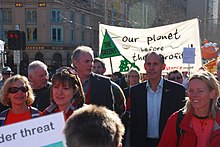
 |
| Environment |
|---|
|
Beginning as a conservation movement, the environmental movement in Australia was the first in the world to become a political movement. Australia is home to United Tasmania Group, the world's first green party.[1][2]
The environmental movement is represented by a wide range of groups sometimes called non-governmental organizations (NGOs). These exist on local, national, and international scales. Environmental NGOs vary widely in political views and in the amount they seek to influence environmental policy in Australia and elsewhere. The environmental movement today consists of both large national groups and also many smaller local groups with local concerns.[3] There are also 5,000 Landcare groups in the six states and two mainland territories. Other environmental issues within the scope of the movement include forest protection, climate change and opposition to nuclear activities.[4][5]
In Australia, the movement has seen a growth in popularity through prominent Australian environmentalists such as Bob Brown, Peter Garrett, Steve Irwin, Tim Flannery, and David Fleay.
- ^ "History". Australian Greens. May 2010. Archived from the original on 11 March 2013. Retrieved 5 March 2013.
- ^ Rootes, C. (1 June 2001). "Review article - Environmentalism in Australia". Environmental Politics. 10 (2): 134–139. doi:10.1080/714000542. ISSN 0964-4016. S2CID 145716321.
- ^ Fielding, Kelly; Gulliver, Robyn; Louis, Winnifred (4 April 2022). "The Characteristics, Activities and Goals of Australian Environmental Activist Groups". The Commons Social Change Library. Retrieved 8 July 2024.
- ^ McIntyre, Iain (4 November 2020). "Environmental Blockading in Australia and Around the World - Timeline 1974-1997". The Commons Social Change Library. Retrieved 8 July 2024.
- ^ Gulliver, Robyn (11 October 2022). "Australian Campaign Case Study: Stop Adani, 2012 - 2022". The Commons Social Change Library. Retrieved 8 July 2024.